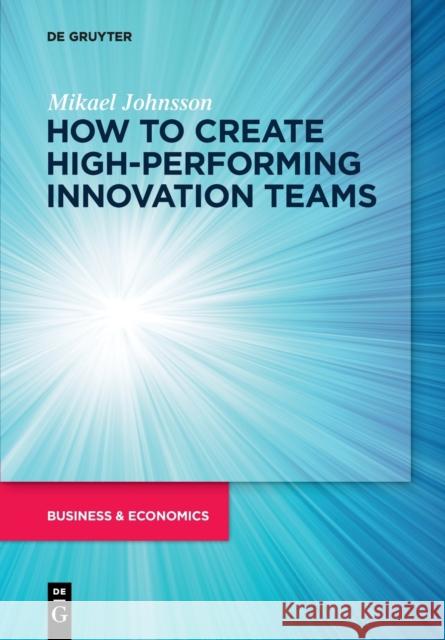How to create high-performing innovation teams » książka



How to create high-performing innovation teams
ISBN-13: 9783110737110 / Angielski / Miękka / 2022
How to create high-performing innovation teams
ISBN-13: 9783110737110 / Angielski / Miękka / 2022
(netto: 174,68 VAT: 5%)
Najniższa cena z 30 dni: 172,15
ok. 16-18 dni roboczych
Bez gwarancji dostawy przed świętami
Darmowa dostawa!
Index
Prologue
1. Introduction and background
Reading instructions
The purpose of this book - a guideline and hands-on methodology
Innovation - do or die
Planning your innovation portfolio
Incremental and radical innovation
The danger of too slim organizations
Shorter and shorter Product life cycles are - speed up innovation work
Innovate for the future
The group development process and its problems - waste of time
Team building the right way
Group or team - it's not the same! Know the difference
The group development process: forming, storming, norming, performing, and dissolving
Creating high-performing innovation teams - a methodology
Summary
Questions for reflection and discussion: Management-, Team- and Team member perspective
2. Organizational conditions for innovation work
Innovation enablers - factors that enable innovation
Innovation enablers in three perspectives - the organization, the team and the team members
The innovation enablers effect innovation teams' work
Organizational structures and innovation teams
Industrial or post-industrial structure affect innovation capabilities
The innovation process - agile work for faster results
Innovation work - not fuzzy and difficult, but more complex
The facilitator - stimulating successful learning
The facilitator - when and how to support the innovation team
Summary
Questions for reflection and discussion: Management-, Team- and Team member perspective
3. High-performing innovation teams in five steps
Step 1 - ensuring management commitment and support
Management is crucial for long term success
Develop understanding on innovation and innovation teams
The sponsor - key person with an important mission
Be patient, it takes time
Begin with a small project, to learn the methodology
Setting directions - invitation to creativity
Empowerment for innovation
Step 2 - identification of convener
Establish conditions for long term learning
The convener is not a project manager
The convener wants change, in collaboration
Step 3 - preparation of the convener
The role of the innovation facilitator
Crash course - this is what to know about
Creating the innovation team according to project focus
Keep management and sponsor updated during preparation
Manage change resistance
If it stops - restart
Step 4 - create the innovation team
key persons - how to select team members
Function before personality
Criteria to fulfil by members
The power of small innovation teams
Multifunctional vs homogenous innovation teams - what's the difference?
Avoiding internal competition in innovation teams
Effective communication for success
The innovation team - a safe place
Step 5 - Kick off
Before kick off - a last check before take off
Time for action
Considering learning as an outcome
On the kick off - how to prioritize activities
Establishing the innovation team - norms and ways of working
Getting to know each other - professionally and personally
Common ownership and responsibilities - why it matters
Setting innovation related goals and sub goals
Breaking the rules - navigating in the organization
Swearing the blood pact - let's do this, full throttle
After the kick off
Summary
Questions for reflection and discussion: Management-, Team- and Team member perspective
4. Innovation team's continued work
The development of the innovation team - thing to watch out for
Challenges for the newly created innovation team
Avoiding isolation - Increasing collaboration for progress
Questions for reflection and discussion: Management-, Team- and Team member perspective
5. Innovation teams in a global setting - working distributed
Distributed high-performing innovation teams in global companies
Challenges for global companies conducting distributed innovation work
Questions for reflection and discussion: Management-, Team- and Team member perspective
Mikael Johnsson earned his PhD 2016 at Blekinge Institute of Technology, where he developed knowledge on innovation team and factors enabling innovation team's work. As a result, he developed methodologies and knowledge regarding how to create high-performing innovation teams. Currently, his research is on the implementation of innovation teams in various organizations, collaborating with consultancy firms while doing so. Additionally, his research is extended to explore how to create distributed high-performing innovation teams, which he does in collaboration with large global companies.
Based on his research, he published the book "High-performing innovation teams - step by step" in 2018, which is a hands-on book in Swedish on how to plan for and create innovation teams that have the potential to become high-performing.
Mikael is also lecturing at Mälardalen University, where he teaches in product development, mainly on master level, using innovation management- and the design thinking-perspective as core. Alongside his academic work, Mikael is also a management consultant, with innovation management as his main field, supporting organizations to develop their knowledge on how innovation teams can be created that take responsibility for, and are independently active in developing products and services within the organisation they work for. In addition to the theoretical knowledge that Mikael has gained, he also has practical experience. He started developing his own products back in 2002. He has several products on the market and filed a few patents in various product fields as well.
1997-2025 DolnySlask.com Agencja Internetowa
KrainaKsiazek.PL - Księgarnia Internetowa









